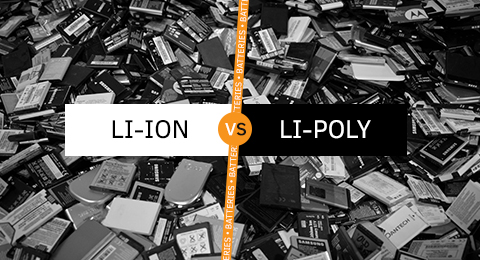Batteries come in all sizes. Some are small and sleek, while a few others are big and bulky. You’ve probably noticed that they also differ in composition: There are those that are built with Lithium-Ion (Li-Ion) and those with Lithium Polymer (Li-Poly). We take a look at the difference between these two rechargeable batteries and how they affect construction of devices.

We’ve had a ton of other batteries before we arrived with two of the most used today. There were the nickel-cadmium and nickel-metal-hydride, battery types which powered the mobile devices of the 20th century.
Lithium-Ion (Li-Ion)

Then came Lithium-Ion, a type of battery in which lithium ions move from the negative electrode to the positive electrode during discharge and back when charging. Development for Li-Ions started as early as 1912 but were only popularized in the 90s when Sony and Asahi Kasei first released them commercially.
Li-ion batteries have high energy-densities. Their capacities can generally be up to twice than that of Nickel-Cadmium ones, and cost usually less to produce and requires low maintenance; hence, most affordable phones are produced with Li-ion batteries in tow. They also have a relatively low self-discharge compared to other batteries, and does not need priming* since it is not a nickel-based battery.
*Priming is a conditioning cycle that is applied as a service tool to improve battery performance during usage or after prolonged storage.
Despite the low-cost production, it has its share of drawbacks. Li-ion batteries are subject to aging even if not being used, it requires a protection circuit to maintain its safe levels of operation, and may be subject to shipment and transportation restrictions especially in large volumes.
Lithium Polymer (Li-Poly)

Lithium-Ion Polymer, more commonly known as Lithium Polymer (also abbreviated as LiPo, Li-Po, but we’re using Li-Poly in this article), were first introduced in the 1970s. It is a rechargeable battery of lithium-ion technology in a pouch format. Unlike cylindrical and prismatic cells, Li-Polys come in a soft package or pouch, which makes them lighter but also lack rigidity. They are far more resistant to overcharge than Li-Ions, and there are less chances for electrolyte leakages.
Since they are made with dry polymer electrolyte, Li-Poly batteries can be flexible and adapt to any size and shape as needed, and can be as thin as a credit card when applied. This results to more devices getting a more slim form factor, as Li-Poly batteries are mostly used by tablets and thin smartphones.
As a result of being flexible and lightweight, Li-Polys carry lower energy densities, suffer less cycle counts, and are more expensive to produce — the cost-to-energy ratio is higher than that of Lithium-Ion. They have the potential to catch fire when punctured or the cells are exposed to air
They also suffer from poor conductivity, as it cannot deliver the current bursts needed to power devices. To compensate, gelled electrolyte are added to most commercial Li-Poly batteries; thus, it does not differ much to their liquid electrolyte counterparts.
In a nutshell
To conclude, the Li-ion and Li-Poly batteries greatly differ — both are equipped with contrasting form factors, costs to produce, densities, and safety features. While they power the same types of devices, they do not cater to the same form — Li-Po makes a device slimmer, and Li-ion makes a gadget bear more power.
At the end of the day, we would always wish for bigger battery capacities to be shipped along with our new devices, and hope that new technologies will emerge to improve one of the most important components powering our gadgets today.

YugaTech.com is the largest and longest-running technology site in the Philippines. Originally established in October 2002, the site was transformed into a full-fledged technology platform in 2005.
How to transfer, withdraw money from PayPal to GCash
Prices of Starlink satellite in the Philippines
Install Google GBox to Huawei smartphones
Pag-IBIG MP2 online application
How to check PhilHealth contributions online
How to find your SIM card serial number
Globe, PLDT, Converge, Sky: Unli fiber internet plans compared
10 biggest games in the Google Play Store
LTO periodic medical exam for 10-year licenses
Netflix codes to unlock hidden TV shows, movies
Apple, Asus, Cherry Mobile, Huawei, LG, Nokia, Oppo, Samsung, Sony, Vivo, Xiaomi, Lenovo, Infinix Mobile, Pocophone, Honor, iPhone, OnePlus, Tecno, Realme, HTC, Gionee, Kata, IQ00, Redmi, Razer, CloudFone, Motorola, Panasonic, TCL, Wiko
Best Android smartphones between PHP 20,000 - 25,000
Smartphones under PHP 10,000 in the Philippines
Smartphones under PHP 12K Philippines
Best smartphones for kids under PHP 7,000
Smartphones under PHP 15,000 in the Philippines
Best Android smartphones between PHP 15,000 - 20,000
Smartphones under PHP 20,000 in the Philippines
Most affordable 5G phones in the Philippines under PHP 20K
5G smartphones in the Philippines under PHP 16K
Smartphone pricelist Philippines 2024
Smartphone pricelist Philippines 2023
Smartphone pricelist Philippines 2022
Smartphone pricelist Philippines 2021
Smartphone pricelist Philippines 2020
Eldon says:
thanks for this article :D really helpful :D
archie says:
Ganun talaga, every pros have cons. Kung mas madedevelop ang prototype kevlar-insulated battery mas dadami ang option for the technology.
“They also offer from poor conductivity,”
*suffer. Not bashing, just correcting it, Carl.
abe santos says:
Marami pa rin yung mga nagsasabi na dapat idrain at icharge ng 6 hours yung mga bagong battery. With li ion technology, that should be avoided right? Marami pa rin ang gumagawa niyan, yung mga mismong nagbebenta ng phone ang madalas na nagsasabi sa mga customer nila. Tsk tsk tsk.